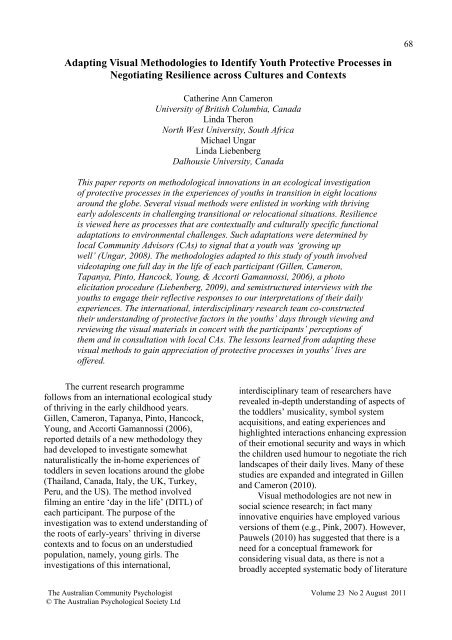The Australian Community Psychologist - APS Member Groups
The Australian Community Psychologist - APS Member Groups
The Australian Community Psychologist - APS Member Groups
Create successful ePaper yourself
Turn your PDF publications into a flip-book with our unique Google optimized e-Paper software.
68<br />
Adapting Visual Methodologies to Identify Youth Protective Processes in<br />
Negotiating Resilience across Cultures and Contexts<br />
Catherine Ann Cameron<br />
University of British Columbia, Canada<br />
Linda <strong>The</strong>ron<br />
North West University, South Africa<br />
Michael Ungar<br />
Linda Liebenberg<br />
Dalhousie University, Canada<br />
This paper reports on methodological innovations in an ecological investigation<br />
of protective processes in the experiences of youths in transition in eight locations<br />
around the globe. Several visual methods were enlisted in working with thriving<br />
early adolescents in challenging transitional or relocational situations. Resilience<br />
is viewed here as processes that are contextually and culturally specific functional<br />
adaptations to environmental challenges. Such adaptations were determined by<br />
local <strong>Community</strong> Advisors (CAs) to signal that a youth was ‘growing up<br />
well’ (Ungar, 2008). <strong>The</strong> methodologies adapted to this study of youth involved<br />
videotaping one full day in the life of each participant (Gillen, Cameron,<br />
Tapanya, Pinto, Hancock, Young, & Accorti Gamannossi, 2006), a photo<br />
elicitation procedure (Liebenberg, 2009), and semistructured interviews with the<br />
youths to engage their reflective responses to our interpretations of their daily<br />
experiences. <strong>The</strong> international, interdisciplinary research team co-constructed<br />
their understanding of protective factors in the youths’ days through viewing and<br />
reviewing the visual materials in concert with the participants’ perceptions of<br />
them and in consultation with local CAs. <strong>The</strong> lessons learned from adapting these<br />
visual methods to gain appreciation of protective processes in youths’ lives are<br />
offered.<br />
<strong>The</strong> current research programme<br />
follows from an international ecological study<br />
of thriving in the early childhood years.<br />
Gillen, Cameron, Tapanya, Pinto, Hancock,<br />
Young, and Accorti Gamannossi (2006),<br />
reported details of a new methodology they<br />
had developed to investigate somewhat<br />
naturalistically the in-home experiences of<br />
toddlers in seven locations around the globe<br />
(Thailand, Canada, Italy, the UK, Turkey,<br />
Peru, and the US). <strong>The</strong> method involved<br />
filming an entire ‘day in the life’ (DITL) of<br />
each participant. <strong>The</strong> purpose of the<br />
investigation was to extend understanding of<br />
the roots of early-years’ thriving in diverse<br />
contexts and to focus on an understudied<br />
population, namely, young girls. <strong>The</strong><br />
investigations of this international,<br />
interdisciplinary team of researchers have<br />
revealed in-depth understanding of aspects of<br />
the toddlers’ musicality, symbol system<br />
acquisitions, and eating experiences and<br />
highlighted interactions enhancing expression<br />
of their emotional security and ways in which<br />
the children used humour to negotiate the rich<br />
landscapes of their daily lives. Many of these<br />
studies are expanded and integrated in Gillen<br />
and Cameron (2010).<br />
Visual methodologies are not new in<br />
social science research; in fact many<br />
innovative enquiries have employed various<br />
versions of them (e.g., Pink, 2007). However,<br />
Pauwels (2010) has suggested that there is a<br />
need for a conceptual framework for<br />
considering visual data, as there is not a<br />
broadly accepted systematic body of literature<br />
<strong>The</strong> <strong>Australian</strong> <strong>Community</strong> <strong>Psychologist</strong> Volume 23 No 2 August 2011<br />
© <strong>The</strong> <strong>Australian</strong> Psychological Society Ltd

















